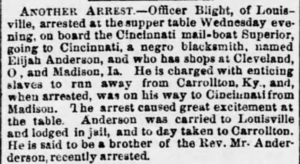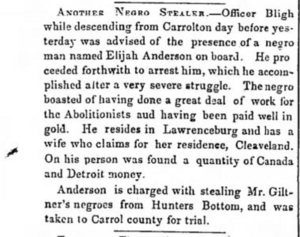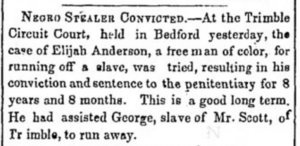Elijah Anderson (Underground Railroad) facts for kids
Elijah Anderson (born 1808 in Fluvanna County, Virginia; died 1861 in Kentucky) was a brave free Black man. He played a very important role in the Underground Railroad. This was a secret network that helped enslaved people escape to freedom. Other people who worked to end slavery, like Rush R. Sloane, said Anderson helped at least 1,000 enslaved people become free.
Elijah grew up when Virginia had strict rules for free Black people. These rules came after slave revolts, like the Nat Turner Rebellion. When he was in his mid-20s, he moved to Cincinnati, Ohio. Later, he married Mary, and they had a daughter named Martha. Between 1835 and 1837, they settled in Madison County, Indiana. There, Elijah worked as a skilled blacksmith, earning a good living.
Elijah was good at making metal parts for wagons and decorative fences. These skills helped him find work fixing metal and steam parts on steamboats. Both Elijah and Mary Anderson were described as light-skinned. This helped them live more safely during a difficult time. In Madison, Elijah became very involved with the local Underground Railroad. He became good friends with other free Black people like George De Baptiste, Chapman Harris, John Lott, and John Carter. Elijah quickly became a leader in the Madison Underground Railroad. They did a lot of work to help end slavery.
Contents
A Leader on the Underground Railroad
Rush R. Sloane, another person who worked to end slavery, called Elijah Anderson the "general superintendent" of the Underground Railroad. This means he was like a main manager. He was known for opening new secret routes and safe houses. These places helped people escape safely to Canada.
Anderson often traveled into Kentucky to talk with both enslaved and free Black people. He often used waterways, like the Cincinnati mail-boat Superior. He also worked well with white people who wanted to end slavery and free Black activists. He made connections in cities like Carrollton, Kentucky, Frankfort, Kentucky, and Lawrenceburg, Indiana. With these connections, he helped make the Underground Railroad stronger in Madison, Indiana.
Facing Danger and Moving On
By 1845, many of the secret routes became known. This made it very dangerous for both enslaved people and those helping them. John Simmons, a successful Black abolitionist, was accused of telling secrets for money. He strongly denied this and sued those who accused him.
Leaders of the Underground Railroad in Madison faced big fines. Many had to leave the state, including De Baptiste, Lott, and Harris. Other helpers were hurt or killed by groups who supported slavery. Because of this danger and the fines, Elijah and Mary moved to Lawrenceburg, Indiana.
In Lawrenceburg, Anderson realized that helping only one, two, or three enslaved people at a time was too slow. He believed it would be better to take larger groups, from twenty to forty people, along the routes. Anderson led many of these escaped people to Cleveland, Ohio. However, Sandusky, Ohio, was often preferred. It was closer to Canada and near the islands of Lake Erie. People say his blacksmith skills helped him create secret codes in messages. These messages were sent between agents and escaped enslaved people.
His Capture and Legacy
It's believed that Elijah Anderson helped between 800 and 1,000 enslaved people reach freedom. Most of this happened after the Fugitive Slave Act of 1850 was passed. This law made it easier for slave owners to capture escaped slaves, even in free states.
Elijah's success ended in the summer of 1856.
At that time, Anderson was guiding a group of escaped people to Cleveland. After he safely completed their journey, Anderson took a steamboat to Cincinnati. On this trip, someone recognized him. A few months later, another activist, William J. Anderson, was mistaken for Elijah. William J. Anderson was accused of helping runaway slaves in Kentucky. He was defended by a lawyer and released.
However, Elijah Anderson was soon recognized and arrested by Delos Blythe from the Alan Pinkerton Detective Agency. General William O. Butler accused him of encouraging slaves to leave their owners. Elijah was found not guilty of this charge. But he was arrested again in Bedford, Kentucky. There, he was accused of helping a boy named George escape.
Sadly, a letter Elijah wrote to his wife was found. It showed that he and other free Black abolitionists were working together to free enslaved people. The strongest evidence against Anderson came from Wright Ray. Ray was a leader of a group that caught escaped slaves. He said he saw Anderson getting on the boat to Cincinnati with the runaway boy.
Because of this, Anderson was sentenced to eight years and eight months in prison. He was sent to the Frankfort, Kentucky, penitentiary. On June 18, 1857, The Louisville Daily Courier newspaper wrote about his conviction.
In April 1861, the day Anderson was supposed to be released, his daughter Martha went to get him. She found him dead in his cell. His death was under unclear circumstances. Some people think officials killed Anderson because of his important work on the Underground Railroad. Others think he died from natural causes. His body was given to his friends and family for burial.
Elijah Anderson's home and blacksmith shop in Madison, Indiana, are still standing today. They are historic buildings and were safe houses on the Underground Railroad. Wilbur Siebert, in his book The Underground Railroad from Slavery to Freedom, wrote that Elijah Anderson was a "brave, and fearless colored man." He said Anderson was the main leader of the Underground Railroad in his area of Ohio. Siebert believed Anderson helped more escaped people than any other dozen men before he was arrested.
Images for kids







